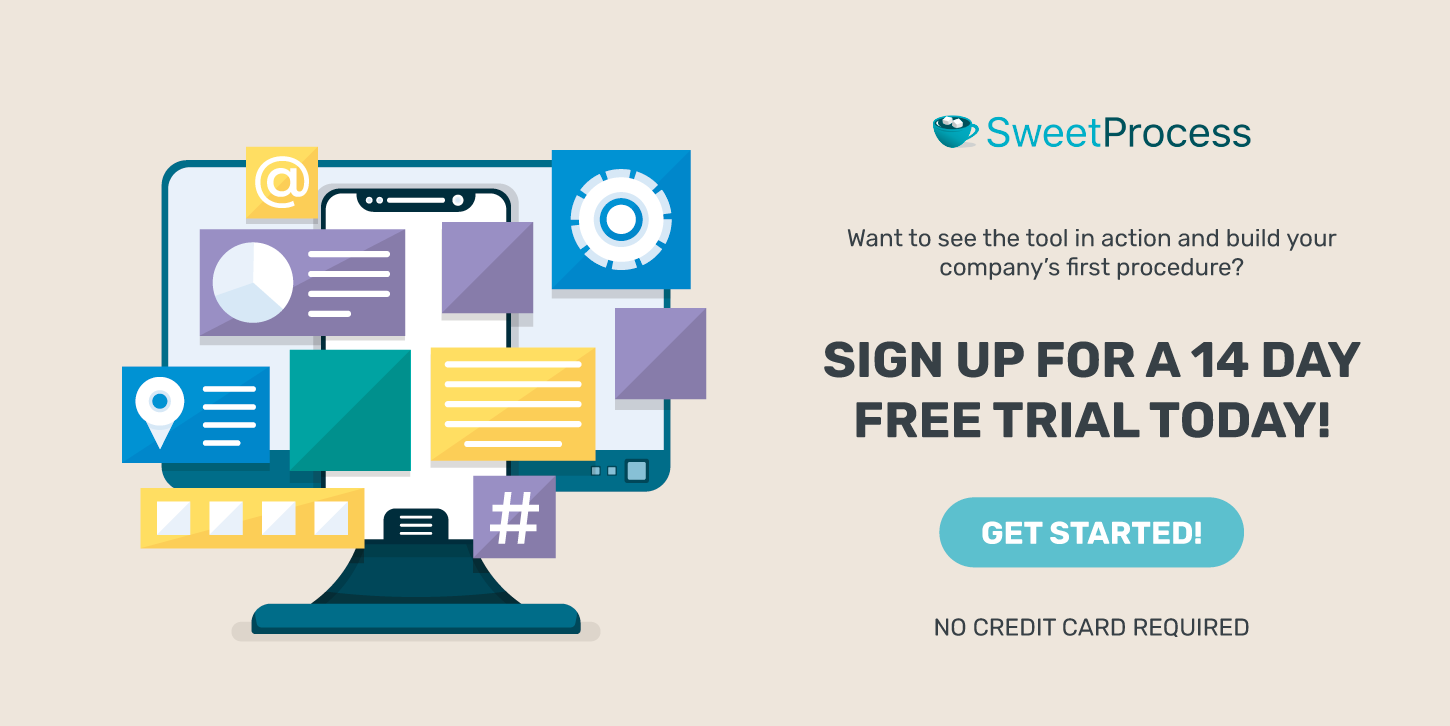Last Updated on March 14, 2025 by Owen McGab Enaohwo
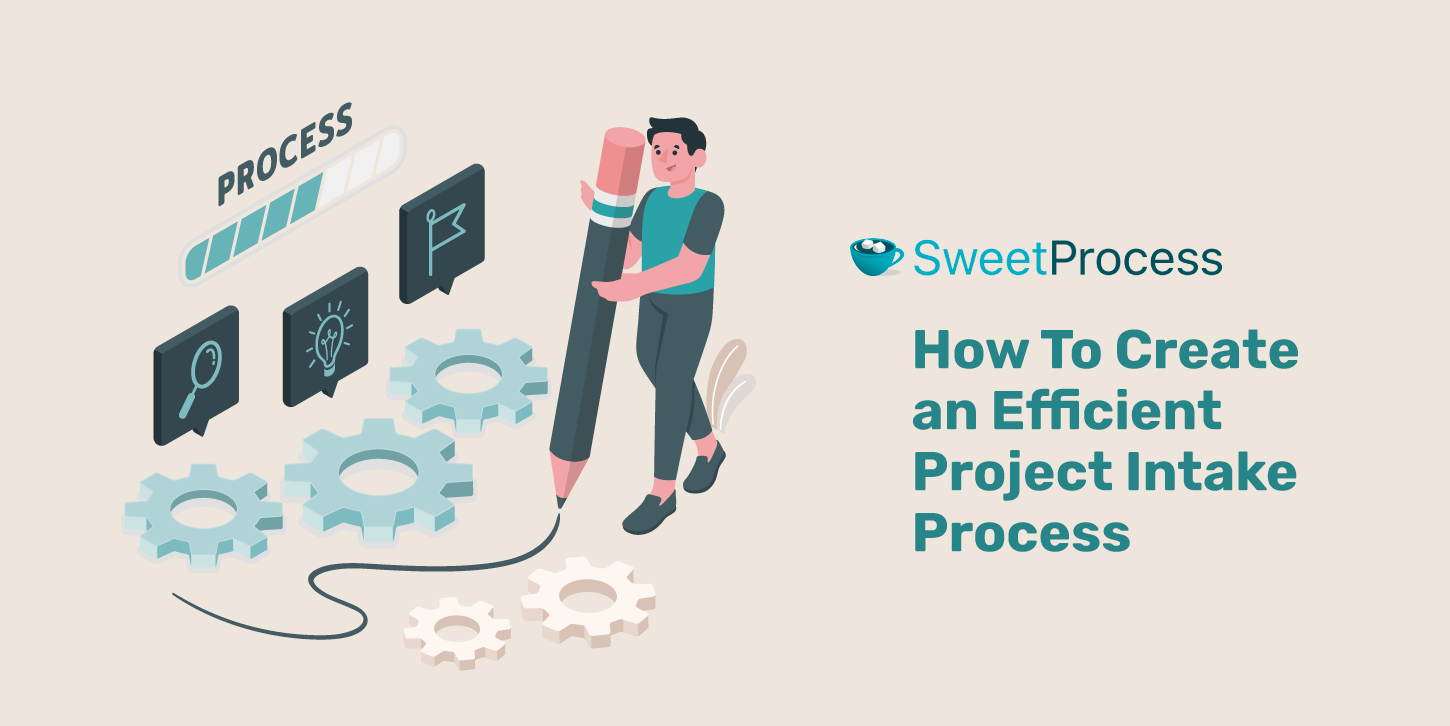
Businesses lose an average of $647,000 annually due to insufficient intake processes.
How can you avoid such a loss?
A recent study by APQC revealed that 65% of companies cite poor intake processes as their number one growth bottleneck. Yet, many organizational goals are to continue operating with inconsistent documentation, scattered workflows, and communication gaps, leading to expensive delays and dissatisfied clients.
Consider The Life Coach School’s journey. Their team of 12 was drowning in ineffective onboarding and scattered documentation, relying on basic tools like Google Docs and video training. This approach seemed sufficient—until missed opportunities and team burnout revealed the cracks in their system. By implementing a systematic intake process, they cut training and onboarding time by 50% while scaling operations toward their $100 million revenue target.
An inefficient intake process isn’t just a minor inconvenience—it’s a silent revenue killer. Every unclear request, every back-and-forth email chain, and every missed requirement adds thousands in lost productivity and opportunities. But with the right approach, your intake process can transform from a bottleneck into a powerful growth engine.
If you’re ready to transform your intake process from the bottleneck in your firm into the growth engine it’s meant to be, then you need SweetProcess.
Sign up for a 14-day free trial and see how fast your intake process turns from your biggest headache into your competitive advantage.
What You’ll Learn In This Guide:
Benefits of an Efficient Intake Process
How To Create an Effective Intake Process
How To Enhance Your Company’s Intake Process with SweetProcess
How SweetProcess Helped Brooks Law Group Streamline Operations
Zen Media Reached Consistency With SweetProcess
7 Intake Process Examples in Different Industries
Enhance Your Intake Process With SweetProcess
What Is the Intake Process?
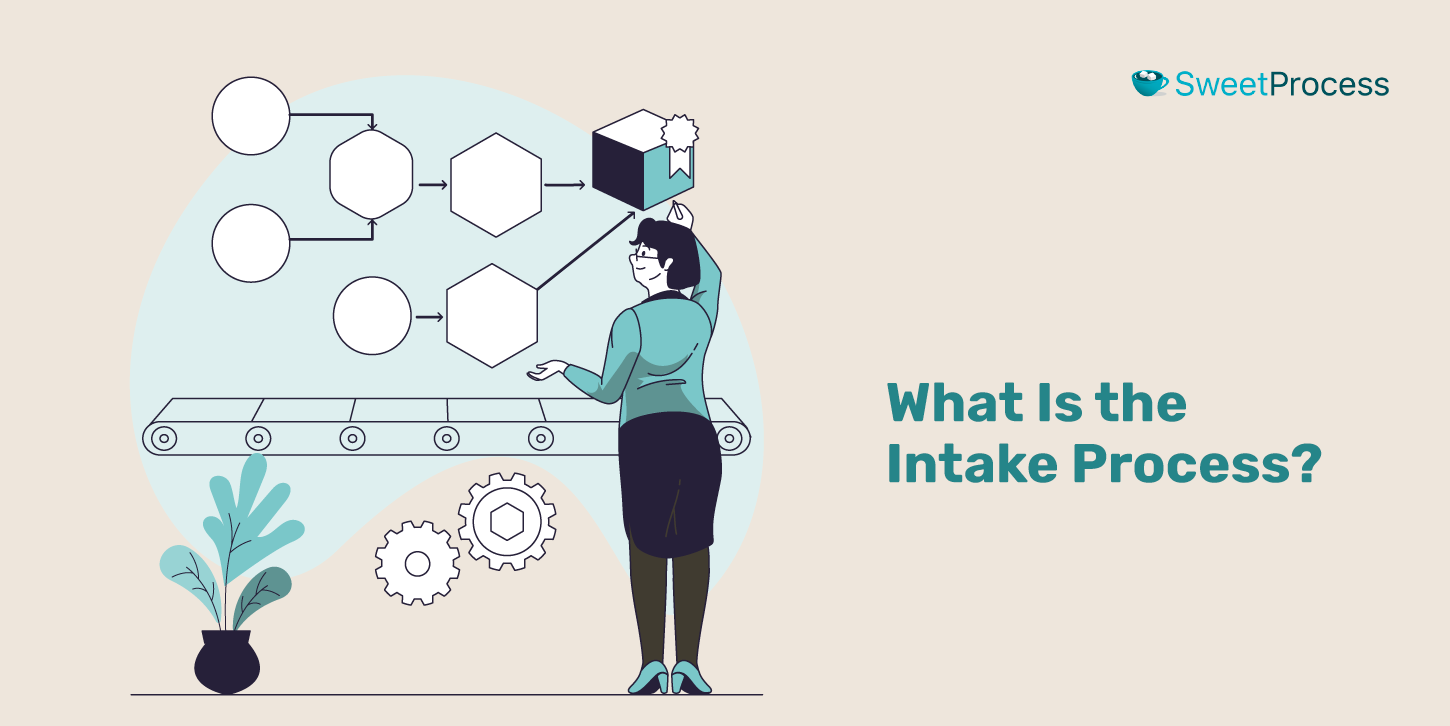
An intake process is your organization’s defined process for assessing and bringing on new projects or customers. Think of it as your organization’s air traffic control system — it’s your structured approach for assessing and bringing in new project ideas, clients, or requests. Without it, you run your business on gut instinct and hope, leaving success to chance rather than strategy.
An effective intake process determines:
- How new requests are evaluated and prioritized
- Who receives and processes each type of request
- What essential information must be captured
- Which criteria determine if a request proceeds
- How work gets routed to the right teams
A good intake process helps your company process incoming project requests efficiently through well-defined channels, leading to better outcomes and satisfied stakeholders.
Are you struggling with building your standardized project intake form? Download our free 16 custom-made client intake templates today and watch your business get the results it needs.
Benefits of an Efficient Intake Process
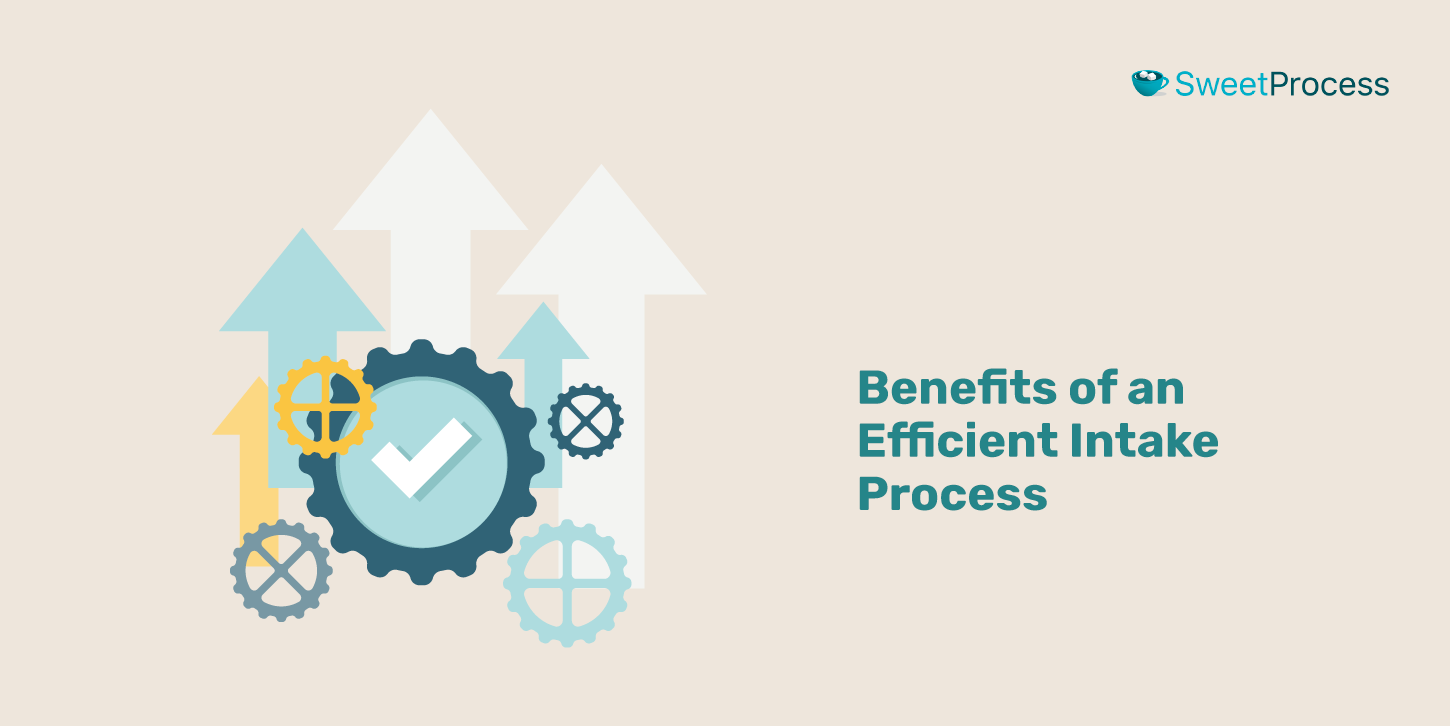
A well-structured work intake process serves as the foundation for operational excellence. Here’s how a streamlined intake process transforms your business operations:
Streamlined Efficiency
The old-school method of incoming project request management via lost emails, hallway huddles, rushed meetings, etc., is akin to collecting rain in a sieve. A good project intake processes creates a single channel for every project request form. When you implement a structured system, you’re not only saving time but also generating space for the highest productivity on tasks. The USPTO revamped its intake process to eliminate bottlenecks, leading to faster patent approvals and improved service delivery.
Enhanced Quality
Quality isn’t accidental. By applying the same evaluation criteria to every project plan, you remove the guesswork, which in turn eliminates missed requirements and scope creep. Instead of patching together bits from various conversations, teams have complete information. Simply getting it right reduces revision requests by 40 percent. The U.S. Coast Guard embraced automation in its client intake process, leading to improved data accuracy and reduced human errors.
Improved Consistency
Remember the game Telephone from childhood? With each retelling, information became distorted. It’s the same in business without a standard intake process. Having a system in place guarantees that every project idea is assessed consistently, no matter who’s doing it. This engenders trust in stakeholders and, more importantly, predictable outcomes on which stakeholders can depend. Western Digital observed improved consistency in operations when they standardized intake processes.
Organizational Clarity
What happens when everyone thinks someone else is covering a project? Leverage accountability through clear intake procedures. Everyone knows their role from initial request to proposed project kickoff because nobody wants to wonder who’s responsible for what or where a project is in the pipeline anymore. Siemens Gamesa Global highlighted in a Forbes article how new intake processes enhanced organizational clarity with project statuses and workflows.
Improved Work in Progress (WIP) Control
You wouldn’t attempt to drink from a fire hose, so why let a project team wash through your organization unchecked? A well-defined intake process serves as a pressure valve for your team; it helps balance your team’s capacity against the highest-impact work that needs to happen. It avoids over-allocating resources, which causes burnout and missed deadlines. AFRY’s integration of new project intake processes led to improved control over ongoing work and enhanced overall project management efficiency.
Ready to transform your intake process from a bottleneck into a business advantage?
How To Create an Effective Intake Process
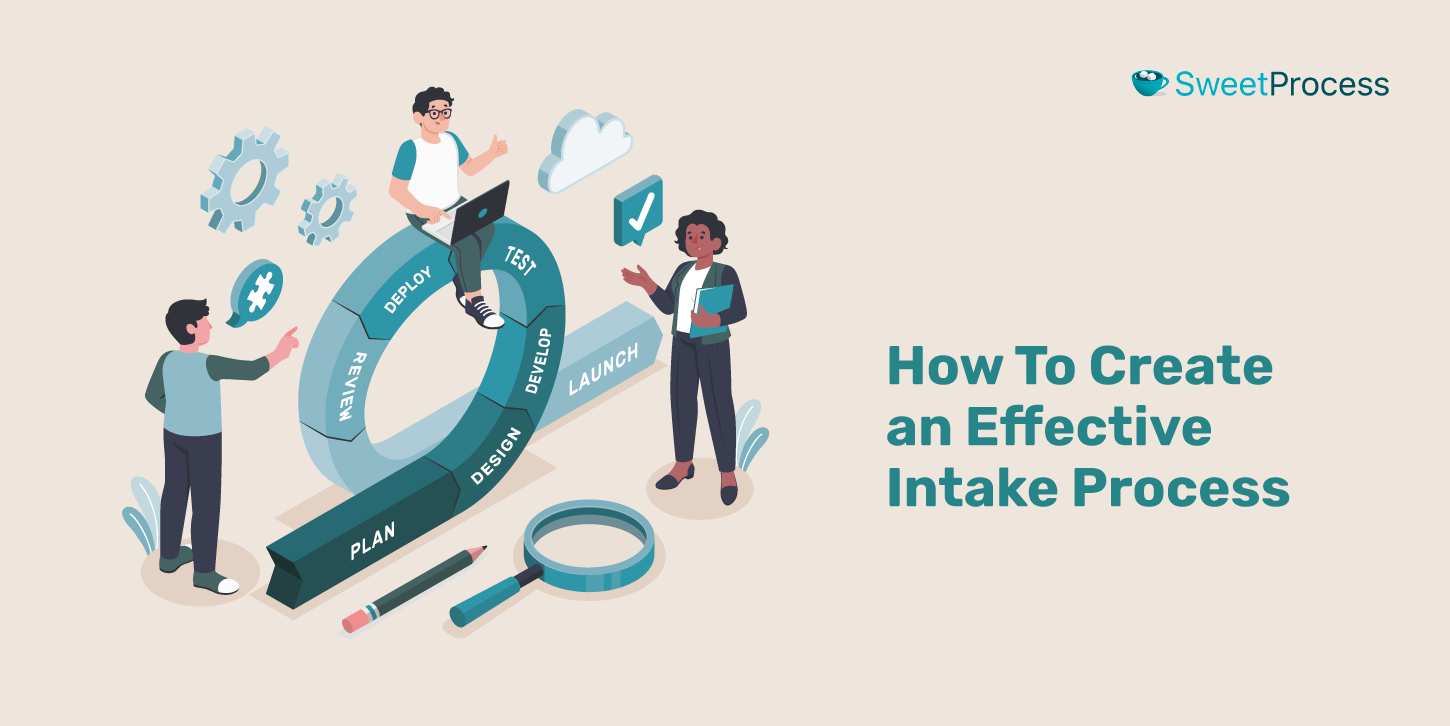
Whether it’s client requests, internal workflows, or customer inquiries, a solid intake system guarantees that nothing slips through the cracks. Let’s go over how you can create a rock-solid intake process that pays dividends in time and mental unloading so that your team can do more with less—work smarter, not harder.
Review How Requests Are Made
Before you address something, you must know where the chaos begins. Break it down and see how requests spill into your system.
Ask yourself:
- Are requests arriving from too many places—emails, calls, chats, handwritten notes?
- Are key details still often missing, resulting in unnecessary follow-up questions?
- Are requests being documented and tracked, or are they getting lost in the shuffle?
For instance, an IT support team that assists employees with tech problems could receive ambiguous emails such as “My computer isn’t working.” Rather than rushing to make sense of a situation, they may use a structured project intake form that solicits specific details—type of device, specific messages, and urgency.
Be Specific About What You Want
Vague requests put the brakes on everything. If your team has to go back and forth all the time to gather more information, that’s a sign that your intake process needs more structure.
How to Fix It:
- Use a standardized project intake form to force requesters to provide the right information upfront.
- Implement drop-down menus and checkboxes to help guide them, streamlining the process for submitting accurate requests.
- Use structured examples to show what a good request looks like.
You can think of it as something like when you order coffee. If someone says only “I want a coffee,” the barista needs to inquire about size, milk type, sugar, and potentially more. But when they say, “I’ll have a large oat milk latte with one sugar,” the order gets processed quickly and without confusion.
Send Requests to the Correct Place
Once you have a clear, structured request, the next challenge is getting it to the right person or department—quickly.
Ways to Streamline Routing:
- Assign intake coordinators who assess and route requests quickly.
- Utilize categorization systems so requests are automatically sorted by type.
- Focus on the request that needs to be addressed now so that you do not create bottlenecks in your most important work areas.
Imagine a hospital ER where everyone had to see the same physician in order of arrival. Instead, patients are prioritized according to how serious their condition is, allowing for those who require emergency intervention to be addressed first and the rest of the patients to be dealt with as necessary. The same is true for business workflows: How they get sorted and routed will make all the difference.
Automate Where You Can
Dealing with each request manually is a productivity killer. Automation can remove repetitive tasks, eliminate human errors, and accelerate processing times.
How to Implement Automation:
- Streamline the process using digital forms that automatically categorize and route requests.
- Create confirmation emails so the requesters can know their submission has been received.
- Create built-in workflows so work is automatically assigned and registered.
A law firm responding to new client inquiries, for example, could create an online client portal form that asks prospects to enter case-related information. The application of this innovation allows for quicker review of incoming cases, allowing the system to filter submissions and directly assign cases to the correct teams as opposed to reviewing every single case manually.
Track and Optimize Continuously
Even a well-crafted intake process isn’t a set-it-and-forget-it system. You have to monitor its performance and react accordingly.
What to Monitor:
- Turnaround time: How long does it take to process and resolve requests?
- Accuracy rate: Are requests being processed accurately the first time?
- User feedback: Are there common pain points that need to be fixed?
It’s like tuning up a car. You don’t just run the car without checking the oil or air in the tires. Regular tune-ups ensure that everything continues running smoothly and help prevent future breakdowns.
Everything highlighted above—structured forms, automation, tracking—can be done in a streamlined manner with one solution.
How To Enhance Your Company’s Intake Process with SweetProcess

Improving your company’s client onboarding process is vital for providing remarkable customer service, project prioritization, smoothing operations, and spurring business expansion. Here’s how SweetProcess can assist you in achieving your potential project .
Familiarize Your New Client With Your Company’s Procedures and Processes
First impressions matter. When a new client comes on board, they need to feel confident and informed. A well-defined intake process will help them understand the workflow of your business, how you operate, and what are the contact points to be strictly maintained. SweetProcess eliminates that complication by letting you create, update, and publish procedures without hassle.
How To Create Your First Procedure In SweetProcess
Go to your main dashboard and find the “More” drop-down. Choose “Procedure” from the choices.

In the top right of your screen, spot the “Create Procedure” button. Click it to begin.

In this section, you need to set a title for your procedure. SweetProcess has an AI feature called ”Write With SweetAI” that generates procedures based on your title.
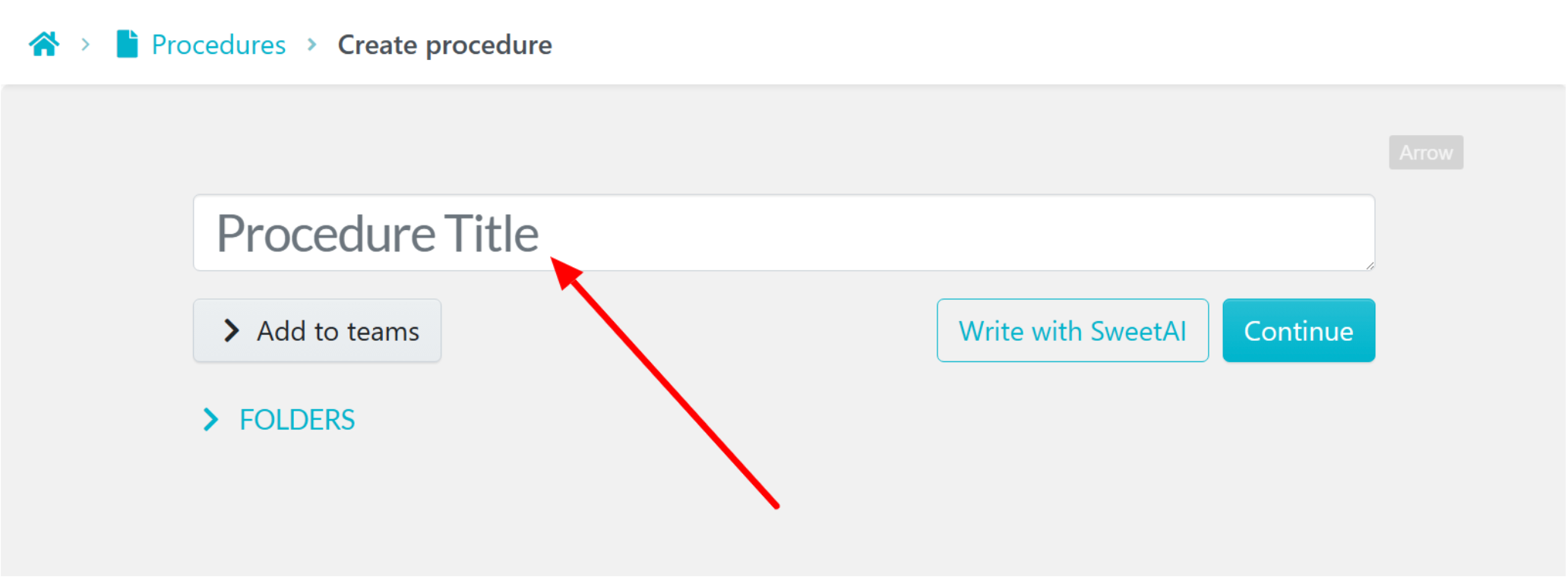
You can share the procedure with your team by selecting the respective departments or groups to share your procedure with the team members.
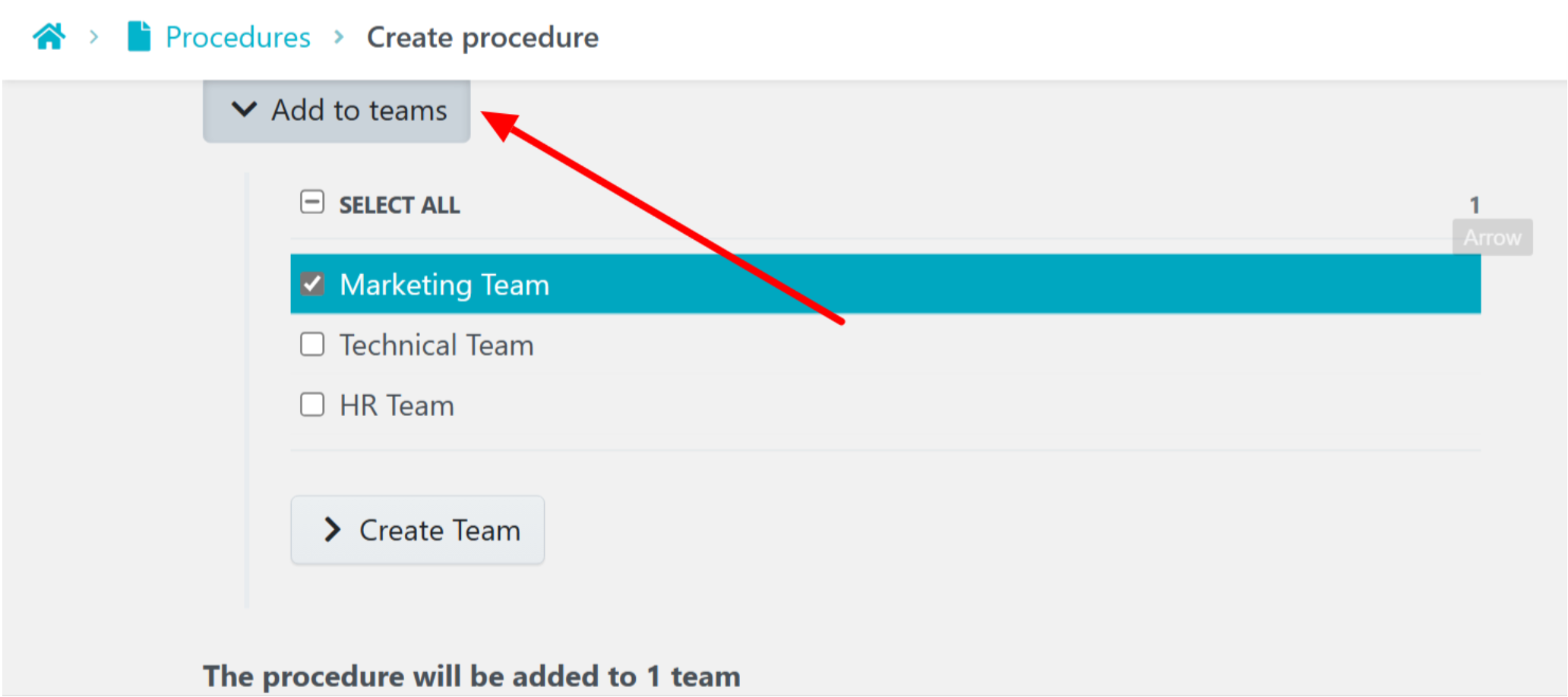
Check the boxes for your target teams and hit “Continue.”

Customize your workflow by clicking the title on the editing screen to add a more informative description of your process.
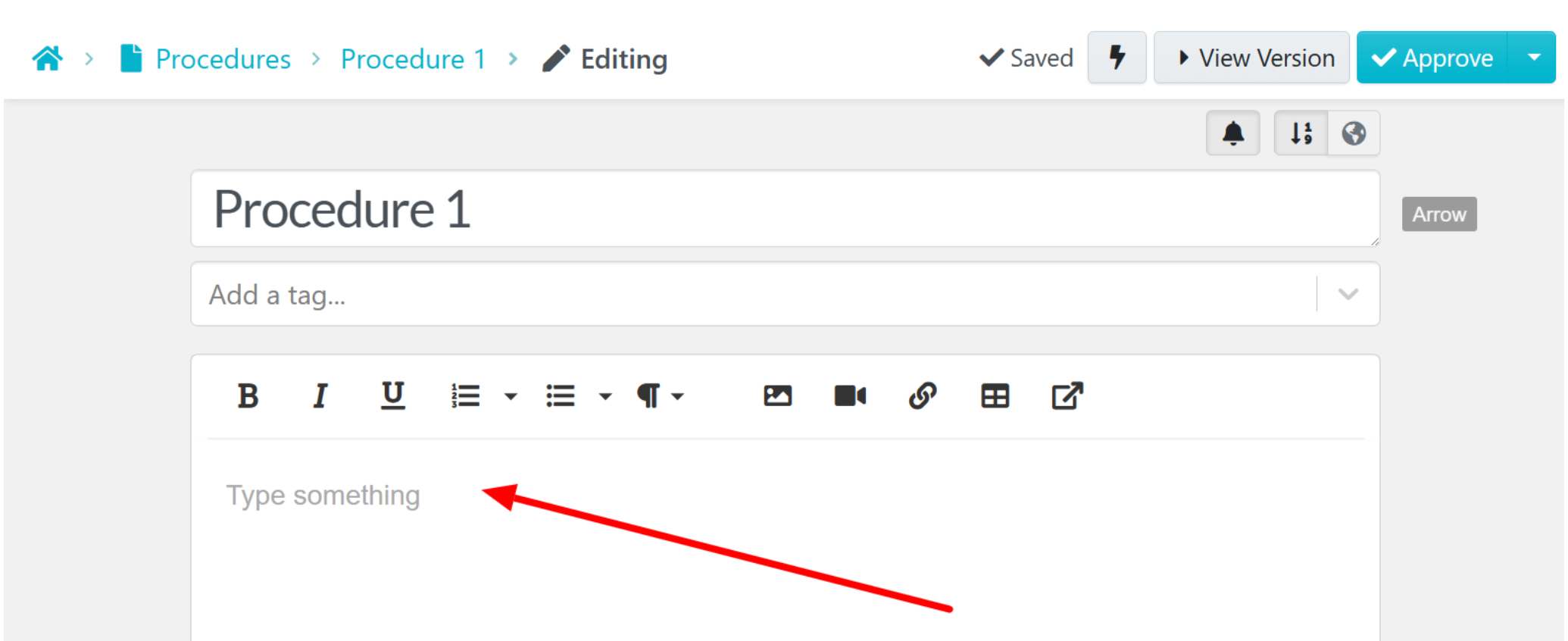
Create your moment one line at a time. Click “Add a Step” at the bottom of your screen.

Build one step at a time. Create each step individually. Start with a clear title, then proceed to provide step-by-step instructions.
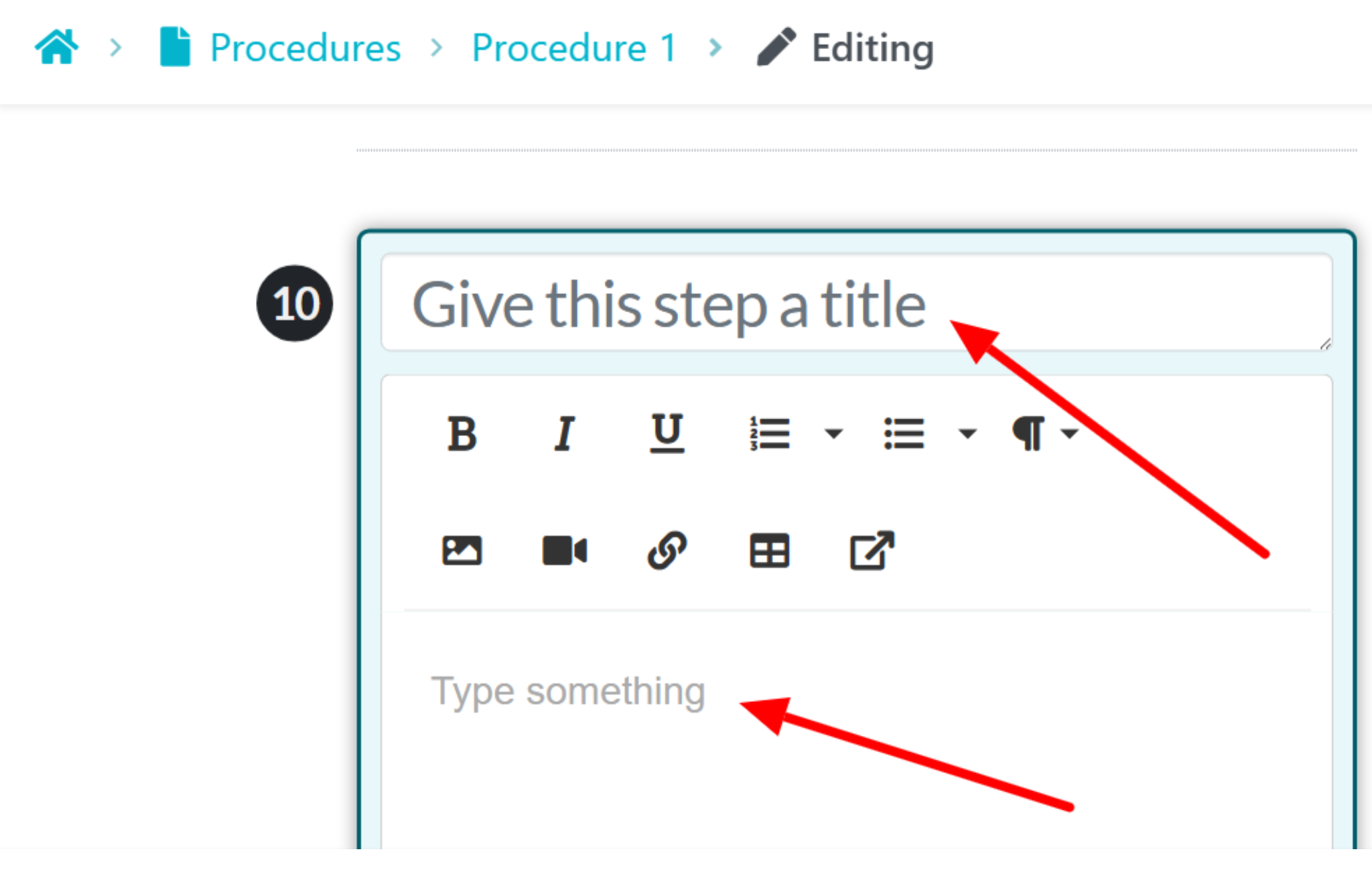
Add visuals that will bring your procedures to life. Insert or link photos, files, or even videos that may be useful. Click on “Finished Editing” to save each step.
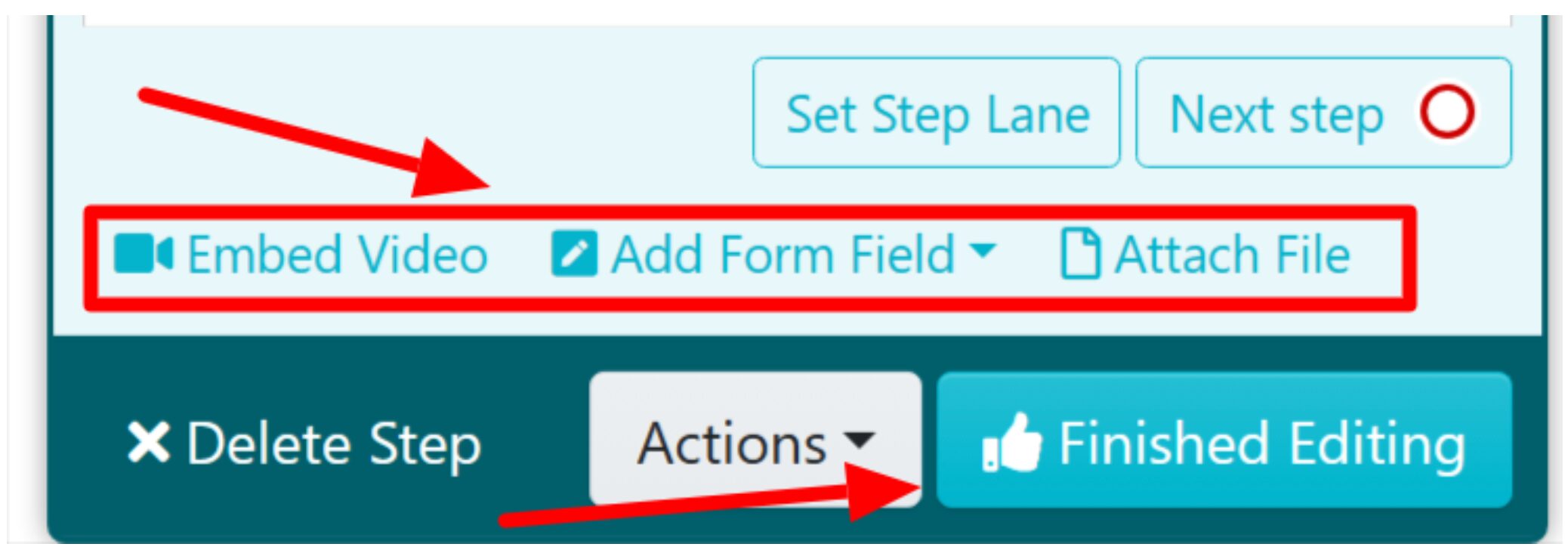
Repeat the step creation process until you have outlined your entire procedure.
Once you have done that, submit your work by using the “Approve” button on the top-right area of your screen.

P.S. Your organization may require certain team members to approve changes. If needed, use “Request Approval.”

Look out for the notification showing your procedure is now live.

Well done! You have written your first procedure. With regular practice, this process gets even quicker.
Create an Onboarding Checklist That Is Easy To Follow
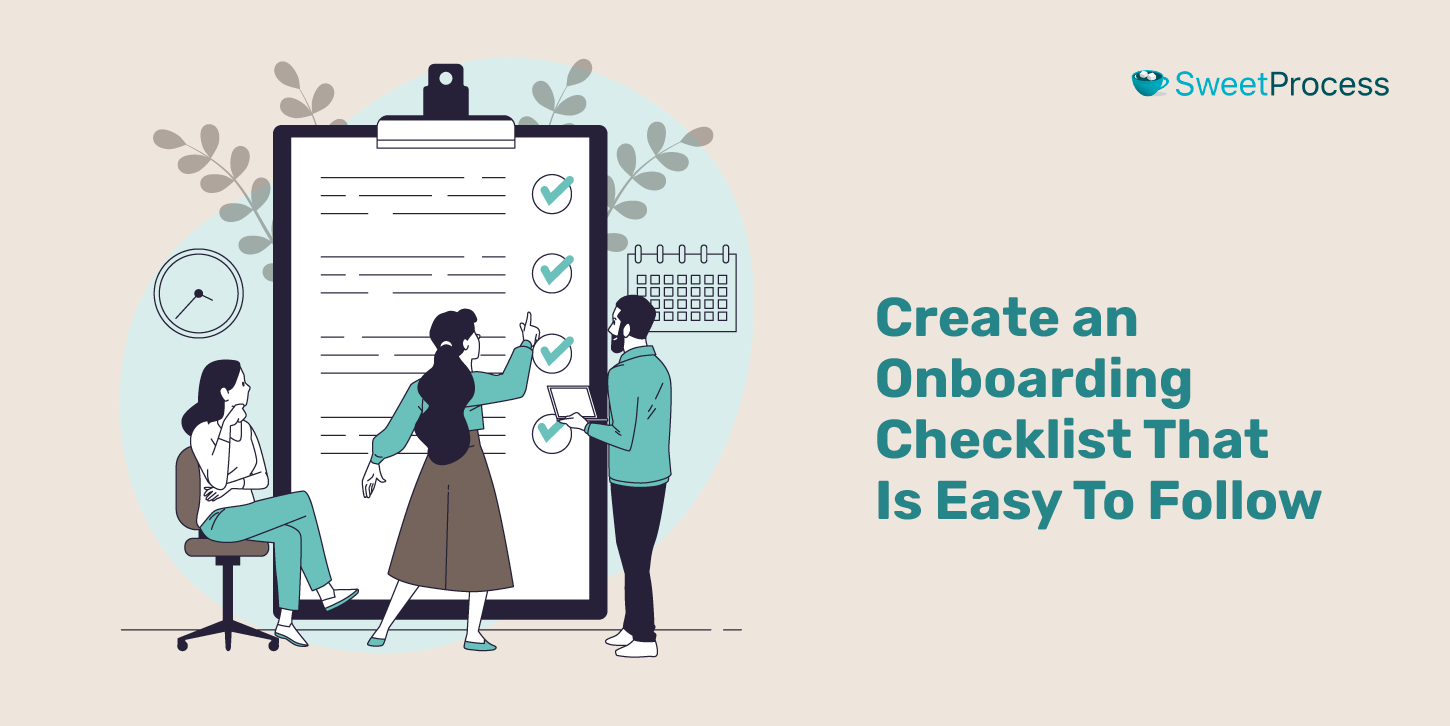
A structured onboarding checklist eliminates confusion and keeps both your team and clients on track. SweetProcess lets you create a step-by-step checklist so that no important step is omitted. Here are the steps involved in creating your checklist.
First, access the “Checklist Creator” through your SweetProcess dashboard. Click “More,” then “Checklists” in the drop-down menu. You’ll see a “Create Checklist” button—click that to start.
Give your checklist a clear name like “New Employee Onboarding” and write a brief description of its purpose. Set appropriate viewing permissions for your team.
Break down the onboarding process into sections. Start with pre-arrival tasks like setup, account creation, and paperwork prep. Then outline first day activities like welcome meetings and introductions.
Structure the first week by listing project initiation, training sessions, department orientations, and initial projects. Outline the first month’s goals, reviews, and performance expectations.
In each section, add detailed tasks by clicking “Add Item.” Write clear, actionable instructions and set realistic completion times. Assign team members to each task. Include helpful links, docs, and videos.
Enable progress tracking with dependencies and completion markers. Set up notifications to keep everyone informed and include verification steps for quality. This maintains accountability.
Test the checklist thoroughly. Complete a full cycle, check attachments, and confirm notifications are sent correctly. Update any unclear steps.
Follow best practices like simple instructions, time estimates, relevant contacts, and regular updates based on feedback.
Assign Client Intake Process as a Task to a Team Member

You use delegation to achieve efficiency. Assigning intake responsibilities to specific team members prevents bottlenecks and ensures accountability. With SweetProcess, you can create tasks, assign them, and track their progress while sending reminders automatically within the system. This keeps everybody in their lane and ensures clients receive the attention they request without delay.
Here’s how to assign tasks in SweetProcess:
Find the three vertical-dots menu icon. Click to see the drop-down.

Click on the menu and choose “Assign as Task.”
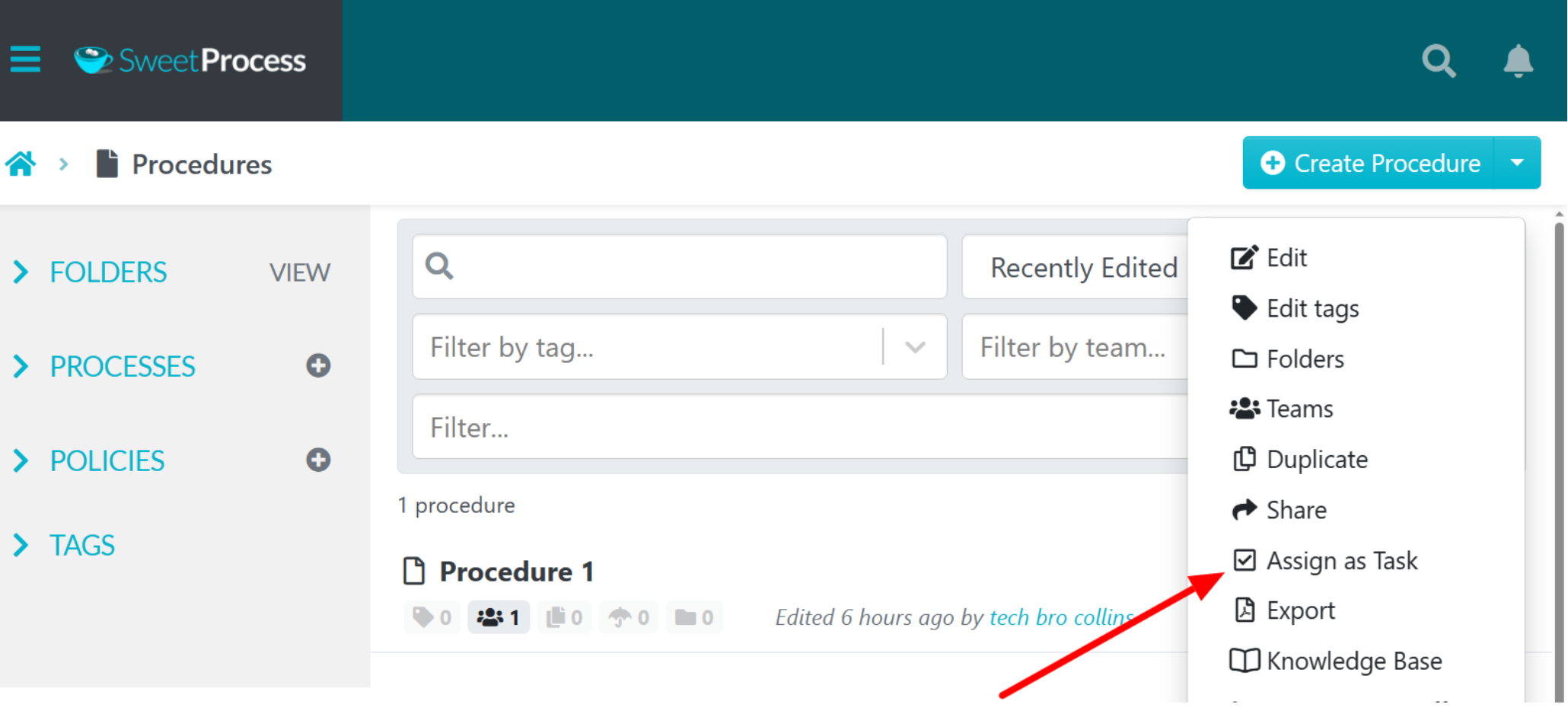
Open the specified procedure and click the action menu or “Actions.”
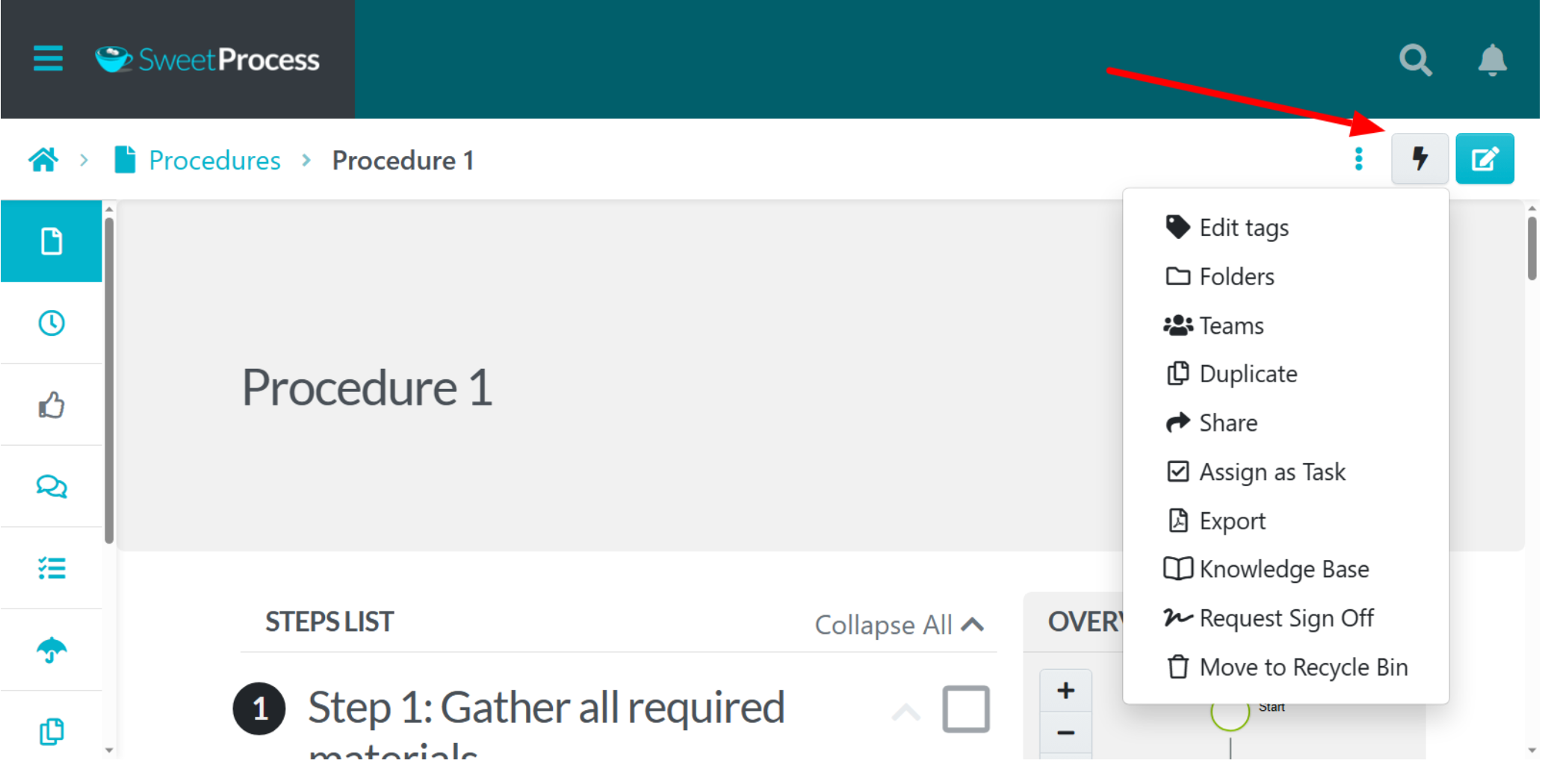
Choose the assignment type: team or individual tasks.
- For team tasks: Assign to the whole group
- For individual tasks: Choose individual team members
Set task frequency by default: “Once Only” for single completion
Return home, and click on the “Repeat” drop-down for recurring tasks daily, weekly, monthly, or yearly.
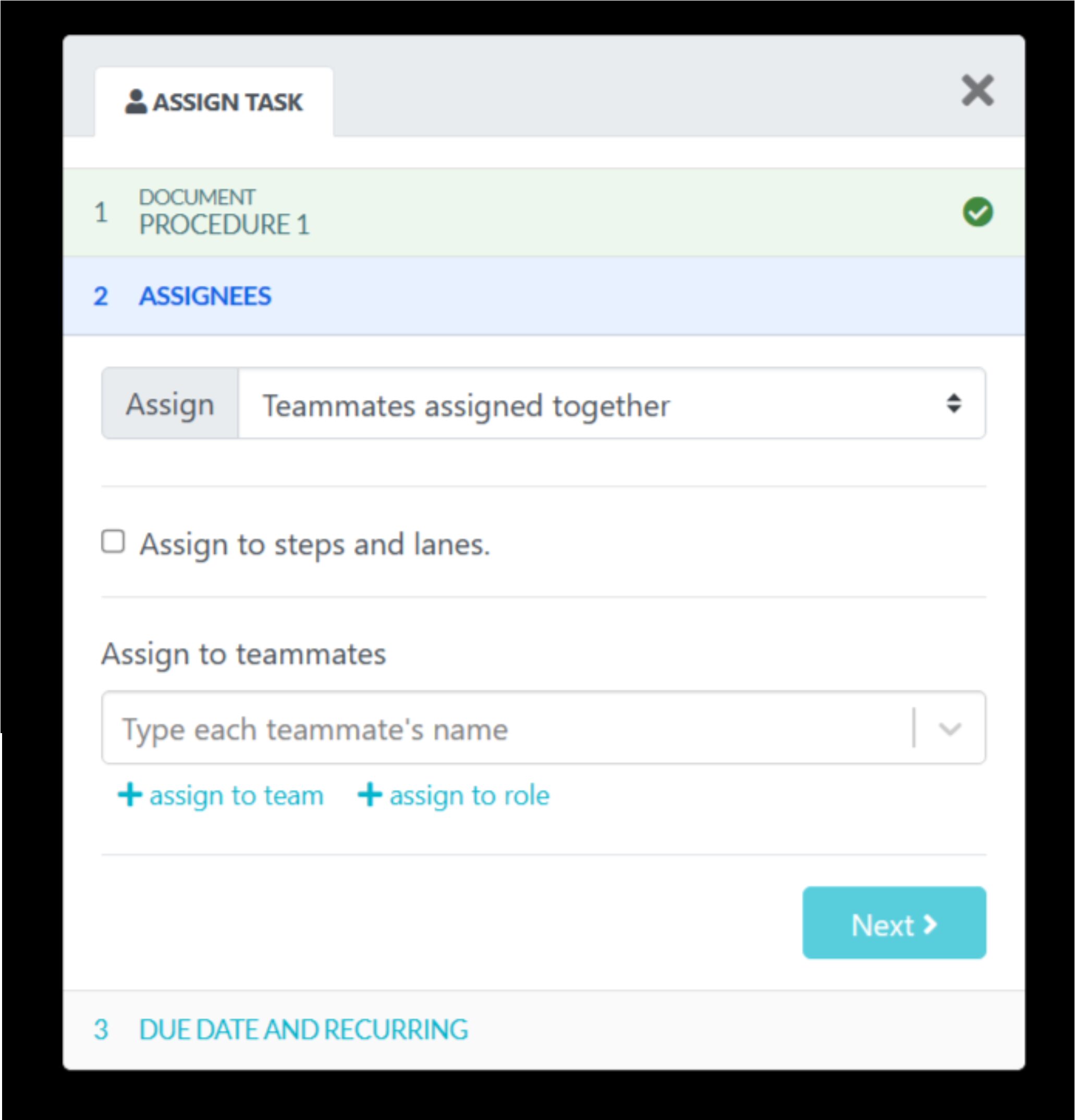
Give Clients Access to Your Company’s Policies
Your clients have to know how your company works, and they need access to your policies. Rather than sending long PDF attachments or linking them to a disorganized website, SweetProcess lets you store and share policies in a neat way. You can even provide various access levels, allowing the clients to view only the necessary information. This keeps it clear and professional and minimizes back-and-forth questions.
Manage Your Knowledge Base in One Place
Scattered information creates inefficiencies and miscommunication. By centralizing all intake-related materials in SweetProcess, your team, and clients have a single source of truth. When you develop an SOP for your team, you can always make edits. Just head over to your dashboard, and all the procedures will be there.
Select the procedure you want to modify. Clicking on the three-dots icon next to each procedure displays a menu with options depending on what your objective is.
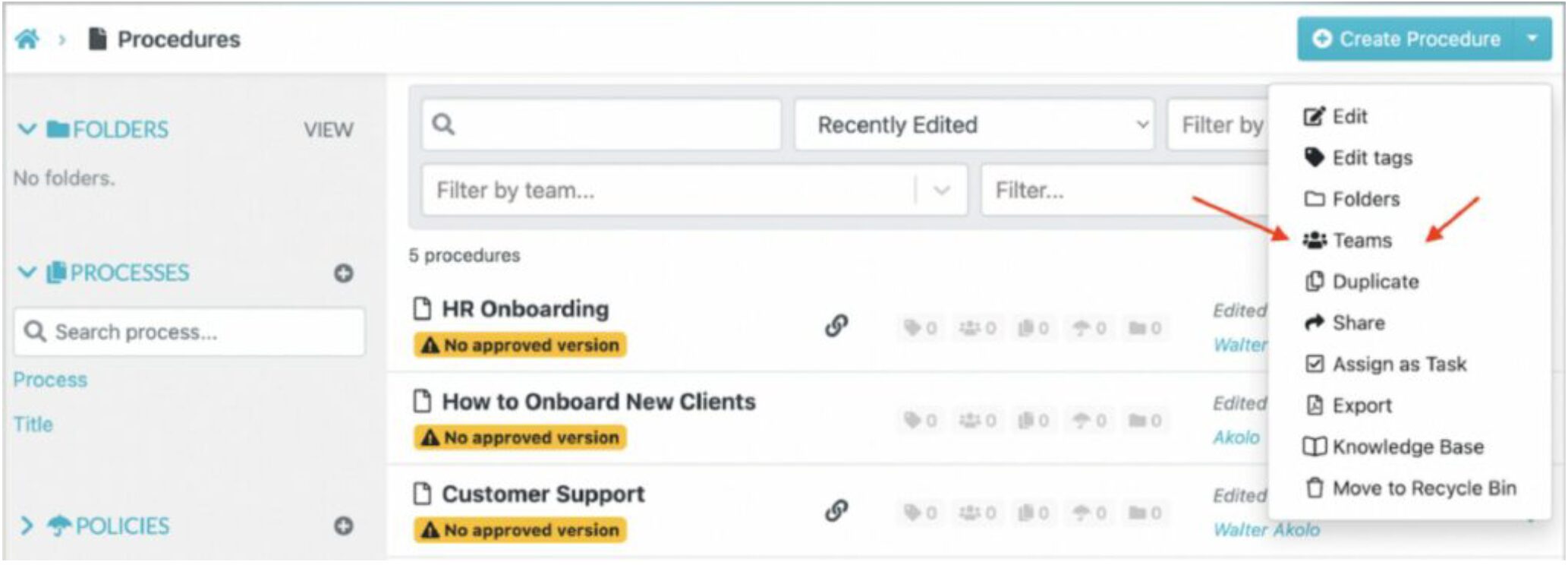
How SweetProcess Helped Brooks Law Group Streamline Operations
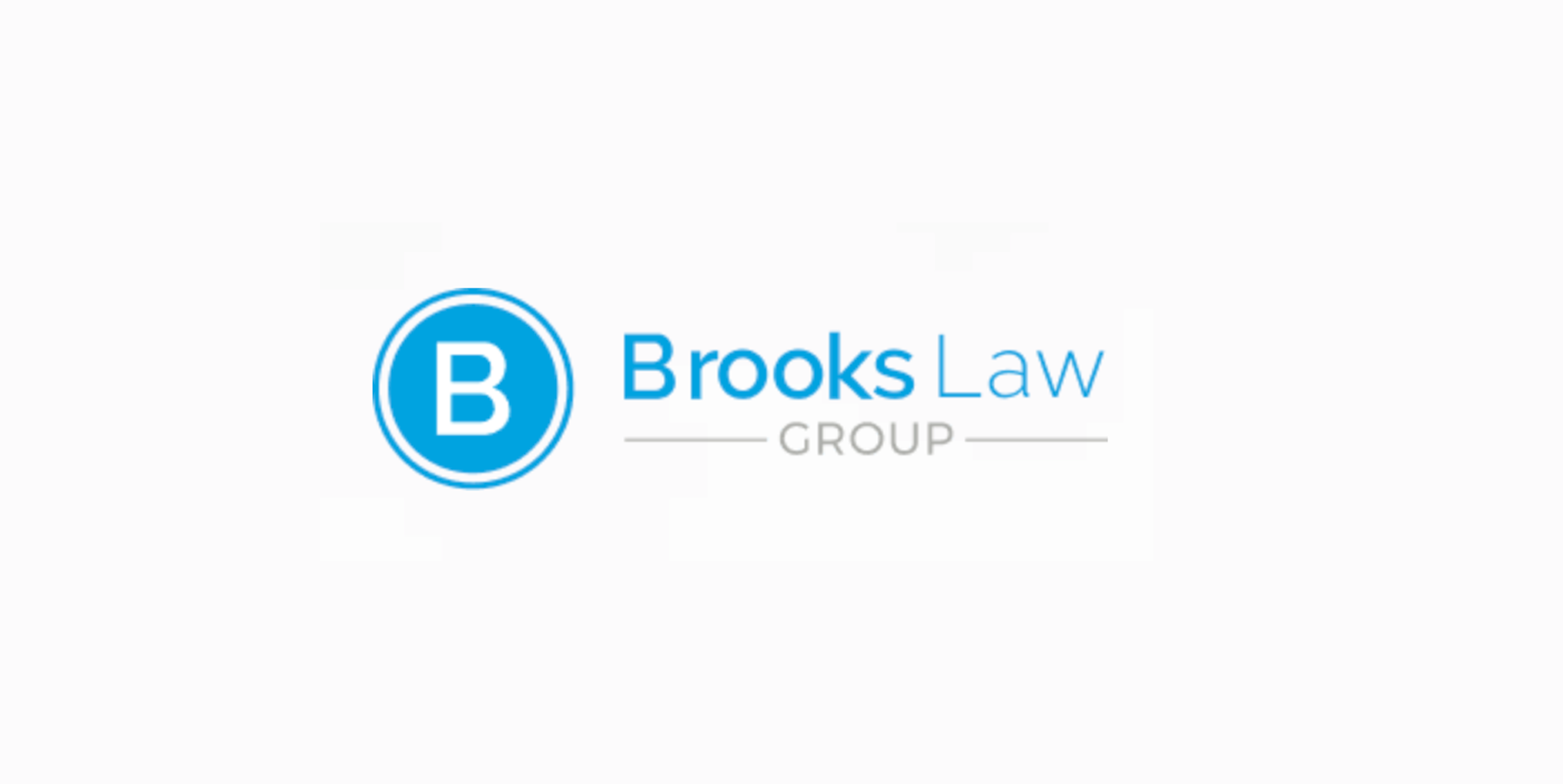
Brooks Law Group is a personal injury firm fighting for accident victims. Laura Johnson, the administrator/HR of Brooks Law Group, knew the firm’s processes needed a major update. Since the firm had a high volume of injured and disabled clients, they needed to work efficiently. Their processes prevented them from working independently or being streamlined enough.
The Challenge
With well-documented processes in place, employees were still taking shortcuts and going to Laura for advice. This reliance slowed progress and left the firm vulnerable to operational hiccups whenever Laura was out of the office. The lack of efficiency was evident, and the firm required a platform that could allow employees to be self-sufficient.
The Solution: SweetProcess
It wasn’t a hard sell, in fact, Laura and a managing partner decided to go with SweetProcess after a compelling demo that showed how easy it could make their lives. The implementation of the software went smoothly, and the advantages were presented from the beginning:
- Transition from scattered documents to a centralized system
- Packaged processes: Making them repeatable and consistent across places
- Self-driven learning: Allowing workers to train on their own
- Business continuity and disaster recovery: Keeping operations running during key personnel absences
The transition to SweetProcess was simple, as existing processes were transferred to the platform and refined to ensure clarity. A full-time staff employee organized the content, and then staff members were trained to use the system effectively.
Results
The implementation led to:
- Improved operating efficiency
- Autonomy of employees
- A resilient workflow that lessens disruption
As Laura puts it, “SweetProcess has freed me as a manager and freed our employees from micromanagement so they can just do their jobs.”
Zen Media Reached Consistency With SweetProcess
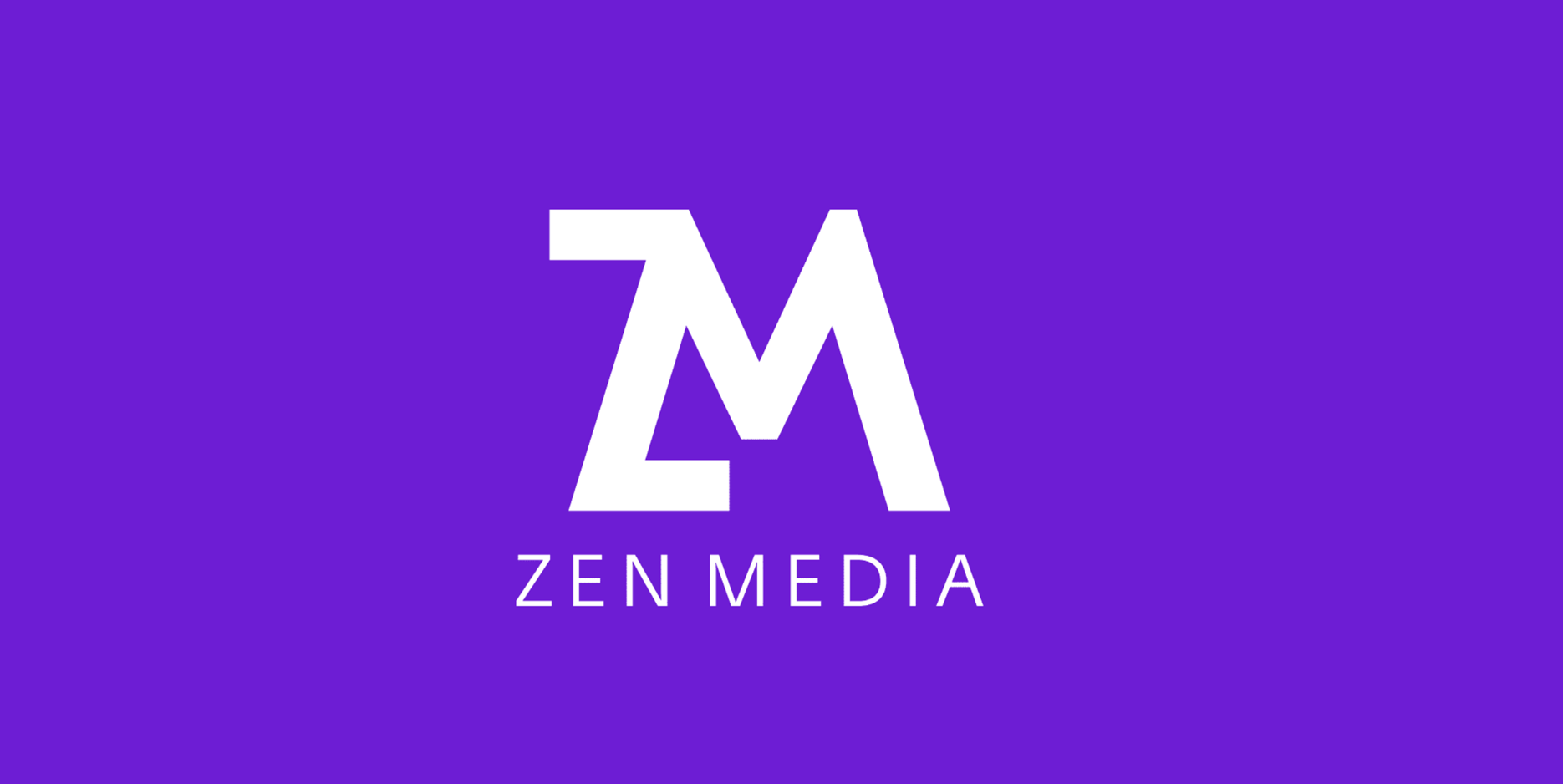
Zen Media, a Dallas-based PR force since 2009, specializes in creating viral moments around brand milestones for B2B and B2C clients around the globe. While they achieved fantastic outcomes for their clients, internally, the agency was plagued with disjointed workflows and knowledge silos.
The Challenge
Despite being brought back as chief marketing officer, Stephanie Chavez faced a major challenge: the agency had no central knowledge base. The company was overly reliant on tribal knowledge, which became a bottleneck when an employee needed to be out for any number of reasons. This rendered the scaling process and quality control challenging.
The Solution: SweetProcess
Stephanie found SweetProcess at a marketing seminar, and the discovery led to the testing of the platform, but it surpassed their expectations.
The results were immediate upon implementation:
- Simplified onboarding: “I send them SweetProcess links and that’s everything they need to get started!”
- Quality control: Making sure all team members follow the same procedures
- Knowledge management: Breaking away from tribal knowledge
Results
The execution changed Zen Media’s processes by providing the following:
- Faster onboarding processes
- Reliable output for clients
- Improved scalability thanks to standardized processes
- Improved team collaboration
Stephanie’s advice for other organizations is succinct: “SweetProcess is game-changing. I looked at alternatives, but nothing compared to its functionality and simple usage.”
These upgrades allow the agency to achieve revenue growth sustainably by growing sales with data-driven processes, serving their clients with the high-quality service they have come to expect.
There are many costs involved with getting clients from your acquisition stages, and a properly constructed intake process can save you from duplication, enhance your client experience, and convert leads into dollars. SweetProcess helps you automate, organize, and optimize every step. Are you ready to take the next step?
7 Intake Process Examples in Different Industries
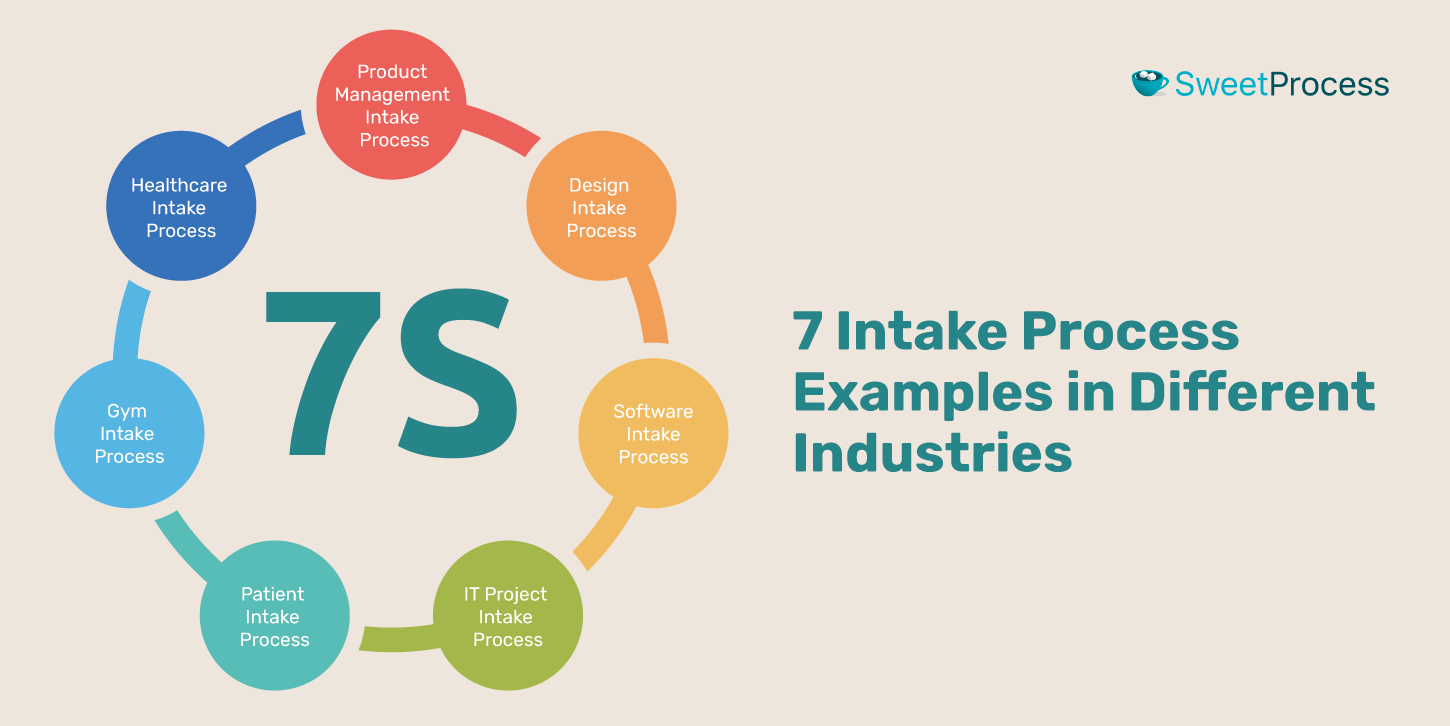
In every industry, the intake process needs are different. This is how structured intake systems ensure smooth functioning across sectors.
Product Management Intake Process
In product management, intake processes help evaluate feature requests, bugs, and improvements before they leave development. An intake process allows product teams to triage by impact, feasibility, and alignment with business goals.
For instance, a tech company can have a different intake form dedicated to feature requests that employees or customers fill out.
Design Intake Process
For designers, intake processes gather information about client needs, brand guidelines, project scope, etc., before any work begins. Designers who lack a structured intake run the risk of numerous rounds of revisions, unmet expectations, and projects dragging on.
For example, a graphic design agency would likely have an intake form where clients share brand assets, preferred color schemes, and examples of similar work they like.
Software Intake Process
Software development teams are tasked with balancing multiple project requests, whether they are internal IT projects or part of new client contracts. An efficient intake process makes sure all technical specs, budgets, and deadlines are documented in advance of writing code.
For example, a SaaS company could have an intake form in which department heads submit software feature requests.
IT Project Intake Process
IT departments field thousands of requests both internally and externally, whether to set up a new employee account or troubleshoot a system problem, but fundamentally, they work on IT tickets. If there is no orderly way to intake requests, IT teams can become inundated and leave time-consuming tasks incomplete.
The benefits of a controlled IT intake process include:
- Submissions in detail by employees via an online portal.
- Requests are automatically routed to the appropriate technician.
- Progress updates are recorded in a single centralized dashboard.
Patient Intake Process
Healthcare professionals utilize effective intake processes to gather patient information, medical history, and insurance details prior to their appointment. A good patient intake system helps provide faster service, minimizes paperwork, and reduces errors.
For instance, a dental clinic may have digital forms where patients fill out their information prior to the appointment.
Gym Intake Process
Intake processes are commonly used by gyms and fitness centers to enroll new members, measure fitness levels, and match clients to appropriate trainers or programs. For example, recommendations for new members might not generate the best suggestions for their strategic goals without a structured system.
Healthcare Intake Process
In such contexts, intake at the hospital or medical practice level is necessary for setting appointments, making referrals, and outlining treatment plans. An optimized intake system allows for accurate and up-to-date patient records.
For instance, a hospital may use an electronic intake system that lets patients enter their insurance information and medical history before they arrive.
No matter the industry you are in, having a good intake process is key for efficiency and client satisfaction.
Tips for a Streamlined Intake Process
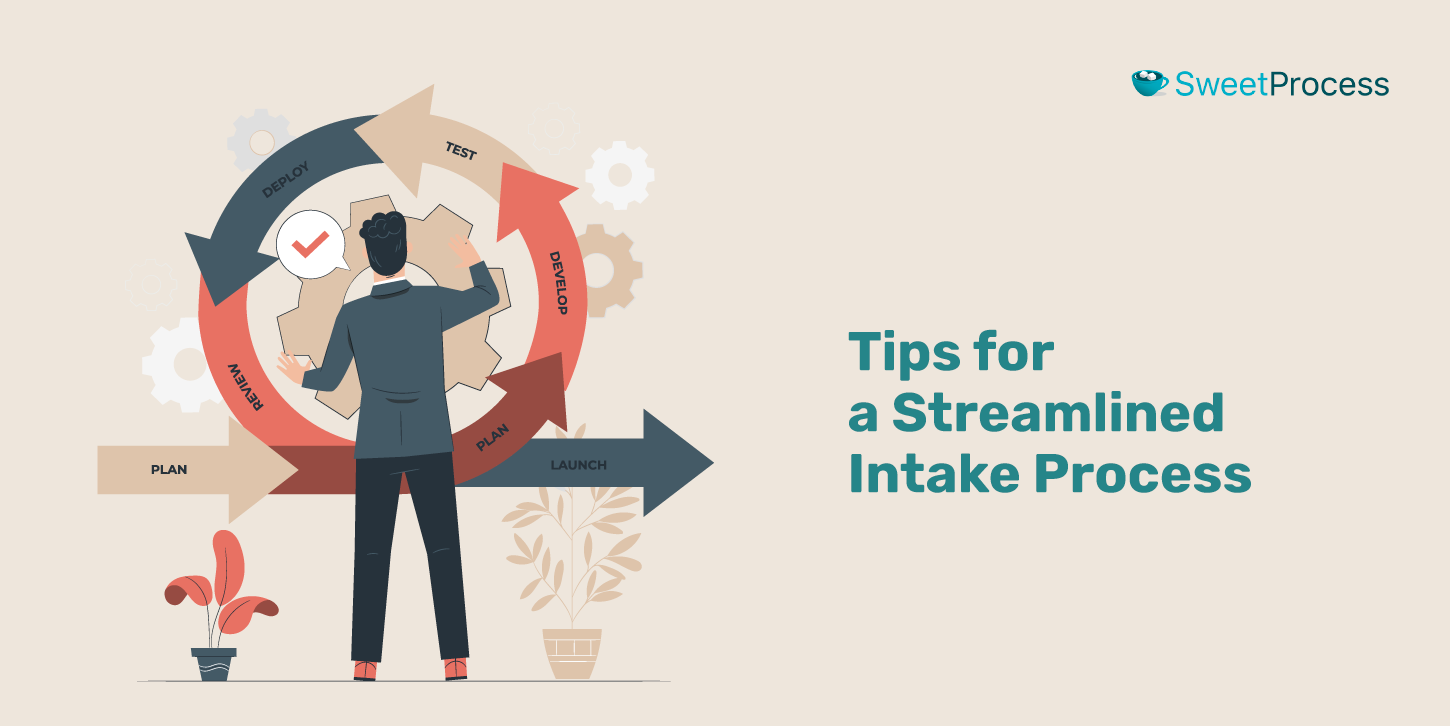
An organized intake process is the foundation for developing strong operations. If done correctly, it breaks down bottlenecks, facilitates communication, and helps to ensure that every request is handled smoothly. Here are a few main points to improve your intake process and principle expansion.
Get Supporting Documentation in Order Ahead of Time
What if you began a project only to discover halfway that you don’t have key information? This not only hinders progress but creates a lot of confusion and lost time as well. To mitigate this, make sure all supporting documentation is in place and accessible before the intake starts.
If you have a business that processes requests from clients, then you can provide them a checklist of all the documents and forms that they need, and things they need to fill. If you handle internal project requests, create a standard document repository where employees can find templates, guidelines, and previous project references. An organized system ensures each element works well to minimize back-and-forth communication delays.
Define Authority and Responsibilities
An efficient intake process isn’t only about a way to receive requests. It’s also about ensuring the right people manage them efficiently. Without established roles, requests may slip through the cracks or be assigned to the wrong person, adding to unnecessary delays.
First, assign various members of your team to be responsible for portions of the intake. For instance:
- A request reviewer/approver (i.e., project manager)
- A coordinator to make sure they collect all needed info
- A specialist who will evaluate the request and its feasibility
When you assign responsibilities, you ensure accountability, so everyone is aware of every request without overlap or duplication of work.
Build an Onboarding Process That Is Both Organized and Efficient
The onboarding process can be chaotic, leading your clients, employees, or stakeholder to feel frustrated and unsure. To prevent this, create a structured onboarding flow with clear steps.
Consider these key elements:
- Standard forms: Make sure your intake forms are simple, comprehensive, and easy to fill out.
- Create automated workflows: Use automation tools to automate the next steps based on responses.
- Timelines that are clear and understandable: Establish and share the timelines for the intake process with stakeholders about how long it will take.
For instance, a marketing agency could implement a structured process where a new client submits a project creative brief and project proposal, the project manager reviews it within 24 hours, and an automated email outlines the next steps. This avoids confusion and ensures smooth progress during the process.
Measure Key Success Metrics
Are you expecting better results from your intake process without measuring performance? Track important metrics to measure efficiency and spot opportunities for improvement.
Here are a few key intake process metrics that you should have:
- Time to complete a request: How fast from beginning to end does an intake request take, from submitting through to being approved?
- Error rate: How often do users submit requests with missing or wrong information?
- Approval rate: What portion of intake requests go on from submission, and what portion does not?
Monitoring these metrics helps us discover bottlenecks, enhance the response times, and provide an overall pleasant intake experience. Regularly revisit the insights gathered and iterate your intake process.
Enhance Your Intake Process With SweetProcess
A streamlined intake process can change the game in how your business processes requests, but overseeing it can be daunting if done manually. This is where SweetProcess comes into play.
Intake processes are easier with SweetProcess because it automates workflows and keep all your documentation in one place, so team members always know what to do and when. From onboarding new clients to processing internal project requests to managing compliance paperwork, SweetProcess organizes every single step so nothing slips through the cracks.
Want to see these in action? Sign up for a free trial of SweetProcess and find the answer you’ve been looking for.
